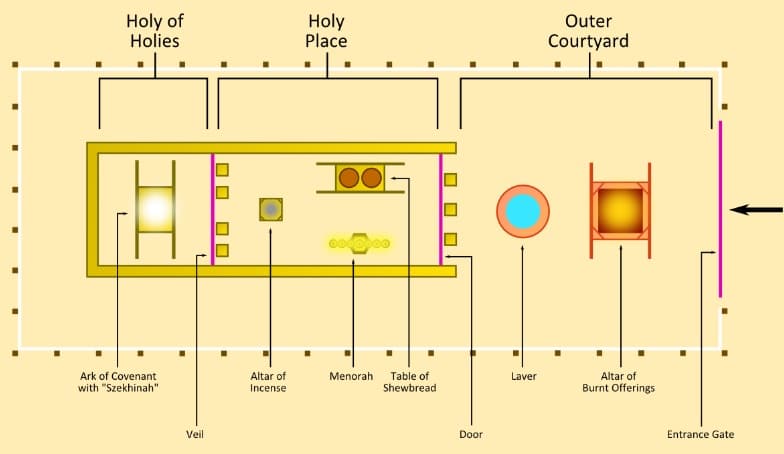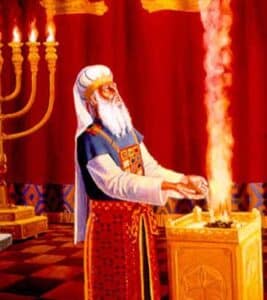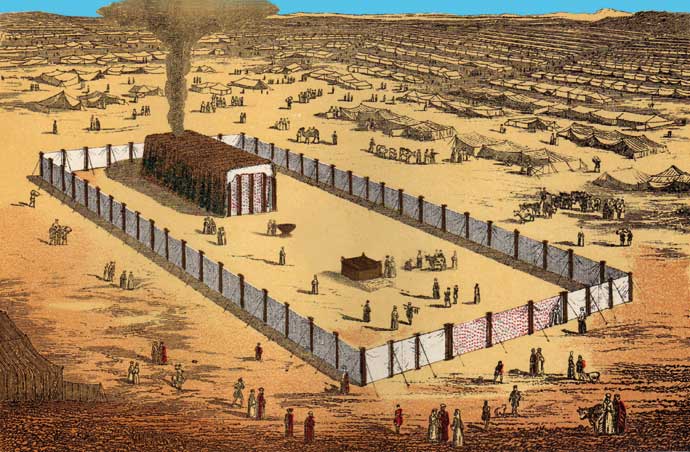We are launching into the second ‘altar’ lesson in this tabernacle study. We came across the first altar just as the Israelite entered the door of the tabernacle courtyard. They entered with their animal to be sacrificed on the bronze altar. They themselves could go no further. The animal’s blood was shed and it was consumed by fire upon the altar. It would be a solemn ceremony: the innocent animal being slain and consumed upon the altar – while the sinning offerer stood by. They must have returned to their tents filled with reflective thoughts. When have you last stood at the foot of the Cross and considered the Lamb of God slain?

“The sun was rising over the horizon as the priest entered the holy place to trim the lampstand and offer sweet incense on the golden altar. He never minimized his high, holy privilege of serving in the Tabernacle. He alone was the mediator who offered intercessory prayer before a holy God on behalf of the nation of Israel.” (1)
The priest is now in the Holy Place. Positioned near the heavy curtain (veil), separating the Holy Place from the Holy of Holies, was the Golden Altar – not bronze! What two other pieces of furniture were in this room?
Now let’s give you the verses pertaining to the Golden Altar of Incense – taken from Exodus 30:1-10. For the purposes of this lesson, we will take the verses from the simpler NLT translation – but you may want to compare it with other translations as well.
“Then make another altar of acacia wood for burning incense. (2) Make it 18 inches square and 36 inches high, with horns at the corners carved from the same piece of wood as the altar itself. (3) Overlay the top, sides, and horns of the altar with pure gold, and run a gold molding around the entire altar. (4) Make two gold rings, and attach them on opposite sides of the altar below the gold molding to hold the carrying poles. (5) Make the poles of acacia wood and overlay them with gold. (6) Place the incense altar just outside the inner curtain that shields the Ark of the Covenant, in front of the Ark’s cover–the place of atonement–that covers the tablets inscribed with the terms of the covenant. I will meet with you there. (7) “Every morning when Aaron maintains the lamps, he must burn fragrant incense on the altar. (8) And each evening when he lights the lamps, he must again burn incense in the LORD’s presence. This must be done from generation to generation. (9) Do not offer any unholy incense on this altar, or any burnt offerings, grain offerings, or liquid offerings. (10) “Once a year Aaron must purify the altar by smearing its horns with blood from the offering made to purify the people from their sin. This will be a regular, annual event from generation to generation, for this is the LORD’s most holy altar.” Exodus 30:1-10 NLT
For additional reading, check out Exodus 37:25-28
Before we go any further, notice the size: 18 inches square and 36 inches high – making it a rather small piece of tabernacle furniture. (Try estimating the size with your arms.) But there it is – the acacia wood totally covered with pure gold, with a horn on each of the four corners and a moulding or gold rim around the top. And, for carrying purposes, there were the gold rings and the gold-plated acacia staves.
 Just pause and appreciate, all over again, the beautiful significance of the gold-covered acacia wood. Sinless humanity and deity – the Lord Jesus Christ! In Lesson 11, we learned the theological term to express this union. The late Sydney Maxwell, a Bible teacher, said the gold is seen in Hebrews Chapter 1, and the Acacia Wood is found in Hebrews Chapter 2. (2) You can read those chapters to see whether you too can see the gold and the wood.
Just pause and appreciate, all over again, the beautiful significance of the gold-covered acacia wood. Sinless humanity and deity – the Lord Jesus Christ! In Lesson 11, we learned the theological term to express this union. The late Sydney Maxwell, a Bible teacher, said the gold is seen in Hebrews Chapter 1, and the Acacia Wood is found in Hebrews Chapter 2. (2) You can read those chapters to see whether you too can see the gold and the wood.
Every morning and evening, Aaron and succeeding priests of the same family line had specific functions to perform. (Notice verses 7 & 8 above) Each day there was a morning and evening sacrifice on the bronze altar in the courtyard. The priest, twice a day, would take a censer full of burning coals from the bronze altar and go inside the Holy Place and place them on the Golden Altar. He would then sprinkle, over the hot coals, a specially prepared sweet incense – causing a cloud of smoke to fill the Holy Place. Given the length of time a collection of burning coals retains its heat, it’s conceivable that a fragrance of incense was being perpetually emitted from this Golden Altar – 24/7.
The High Priest, working within that Holy Place, had to wear a very special outfit and a unique headpiece. The outfit He wore to qualify him to function as High Priest is a focused study itself.
“[But our] Great High Priest does not need garments. His genuine humanity and His work at Calvary have given Him all the fitness needed to be our Priest. Aaron wore a plate of pure gold with an engraving on it: “Holiness to the Lord” (Exodus 28:36). That plate was fastened to the mitre on his forehead and it guaranteed the acceptance of the Israelites before the Lord.
But what about our acceptance before God? Our ‘acceptance’ needs no mitre on His head or gold plate. Christ is pure gold Himself and He is absolutely acceptable to God. We are accepted in Him – continually, to every generation!” (3)
Aaron was a High Priest. Christ is our GREAT High Priest.
The work of the High Priest was continual in the Holy Place – as was the constantly ascending cloudy swirl of fragrance from the Golden Altar. That cloud, curling upwards, was symbolic of Israel’s prayers to God. “Christ, our Great High Priest, is continually making intercession for us. (Hebrews 7:25) A perpetual incense rose heavenward from the Holy Place, reminding us of the unceasing interest and care of Christ for us. There is never a moment when He is not representing us and caring for us at God’s right hand. And that care is likened to incense with all its sweetness and fragrance.” (4)
One more thing before we conclude this lesson: remember the four horns (verse 2 above) on this golden altar? Once a year, on the Day of Atonement, the high priest would take the sin-offering blood from the bronze altar and go into the Holy Place to the Incense Altar and sprinkle / smear/dab each horn with that blood. We should never forget that the ongoing living service and intercession of Christ on our behalf, as our Great High Priest in Heaven, is based on the fact that He is the ‘propitiation for our sins’ – His blood was shed on the Cross.
There are many practical things we could learn about our own prayer life from studying the Golden Altar of Incense – but remember this Tabernacle 101 study is focused on Christ specifically – not so much Christian-living applications. That’s a 200-level course and most instructive and helpful.
Next week, we will look more closely at the actual perfume or incense that was used on the Golden Altar. You will enjoy studying its actual composition, its significance and how beautifully we will see Christ in this lesson.
Sources:
- The Tabernacle, David M. Levy, Kregel Publications, p.53
- http://truthandtidings.com/2005/02/tabernacle-studies-the-golden-altar-or-altar-of-incense/
- A. J. Higgins, Monday Meditations
- ibid.


So if the Golden Altar speaks of Christ’s intercessory work, and that the Great Day of Atonement looked forward to Calvary and the sacrifice that our Saviour was to make, would it be right to suggest that we see in Luke’s Gospel, the Gospel which depicts the Saviour as the Great High Priest, an intercessory prayer from the lips of the Lord Jesus while on the cross, “Father, forgive them; for they know not what they do” – Luke 23:34. If so, Isaiah prophesied this as well in his book, “And He was numbered with the transgressors; and He bare the sin of many, and MADE INTERCESSION FOR THE TRANSGRESSORS” – Isaiah 53:12b. Quite a thing, that in the midst of suffering, He thought and prayed for others.
Thanks for this most important overview of the tabernacle and how it presented the significance of the sacrifice both for the sinned individual and the infinite cost at Calvary. We enjoyed hearing Mr. Higgens in Portage when he gave a message on the ‘significance of the serpent’ in the old testament as well as at Calvary.
Thanks
Allan Ronald